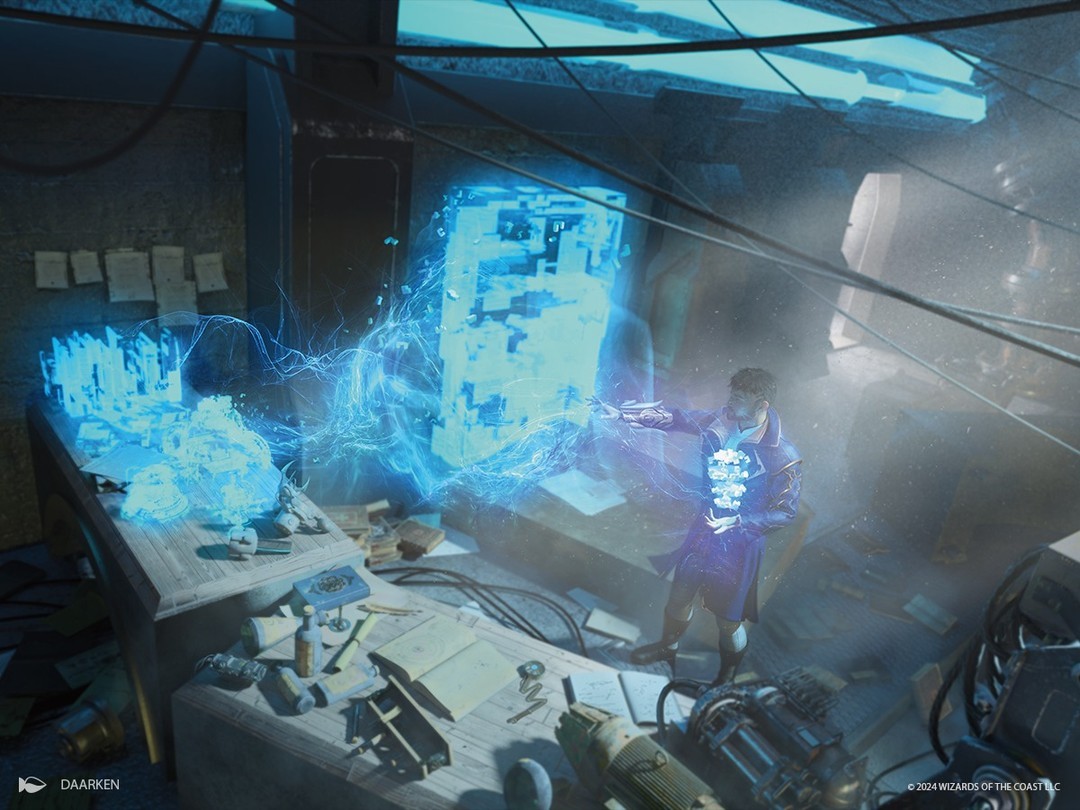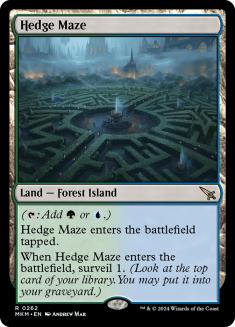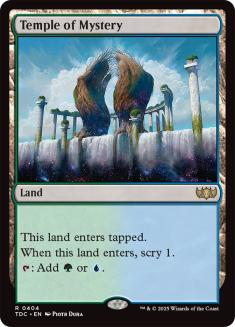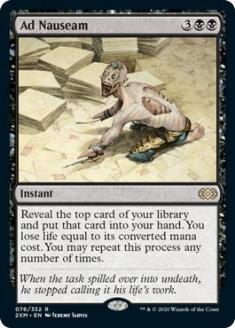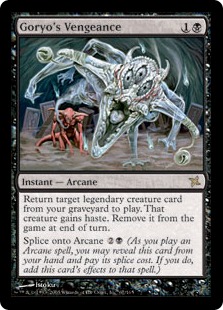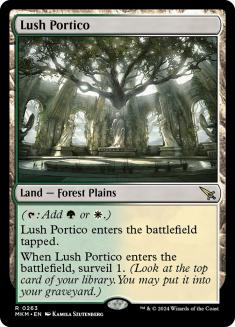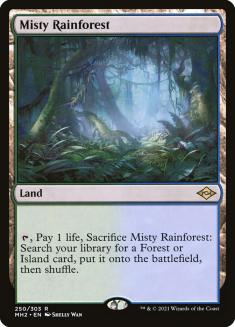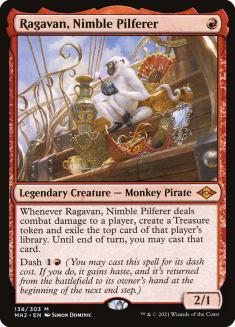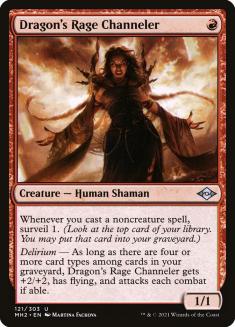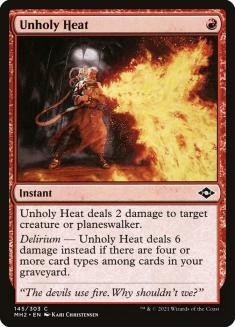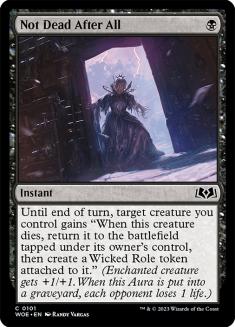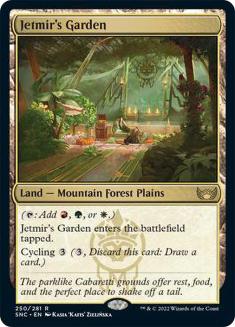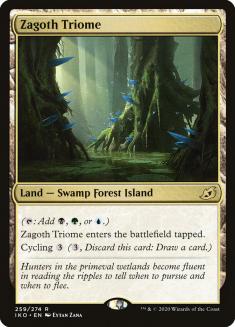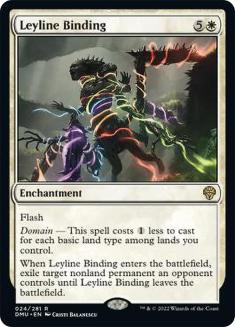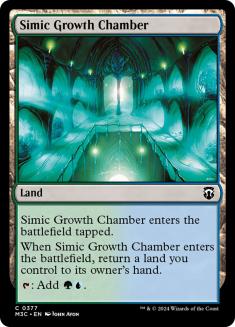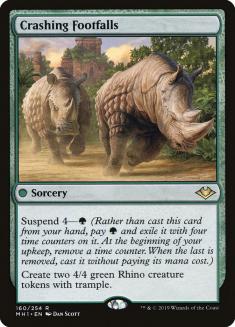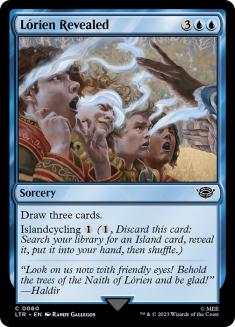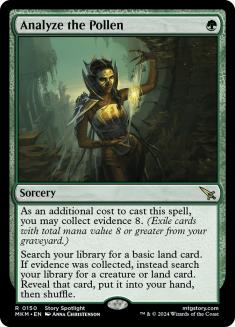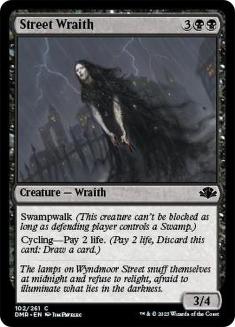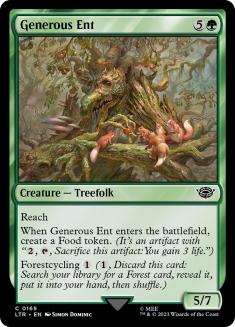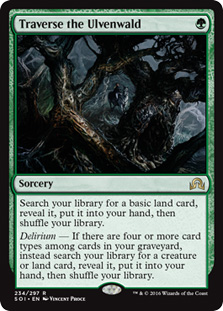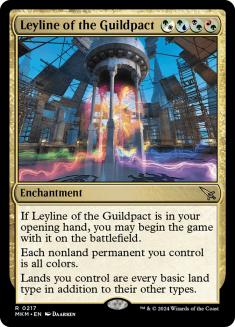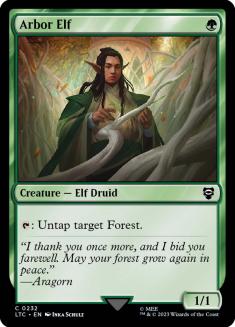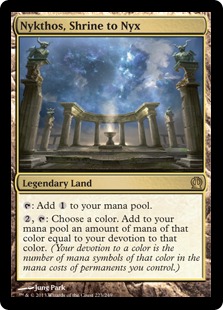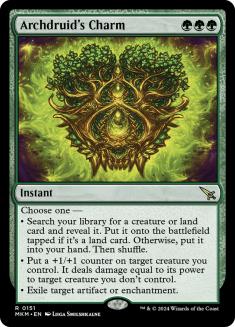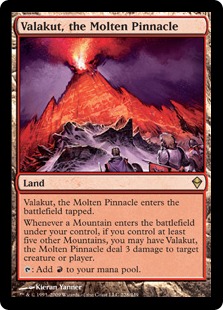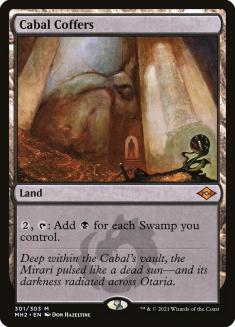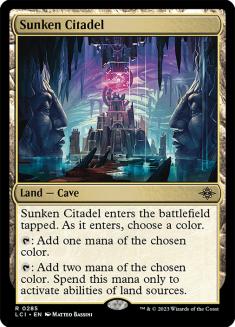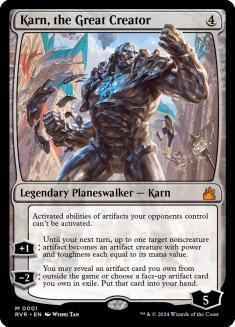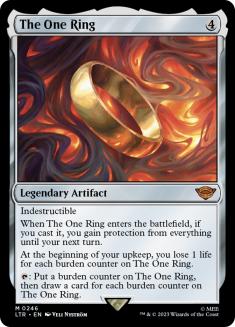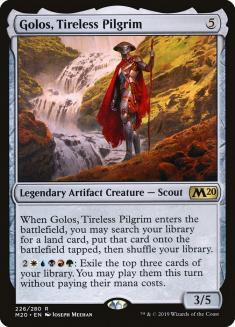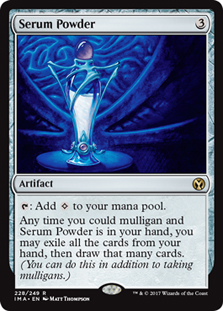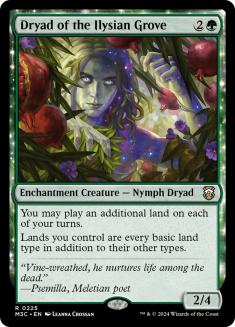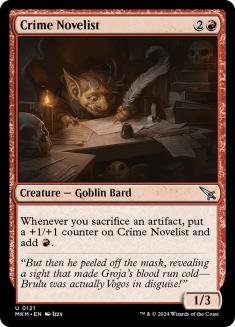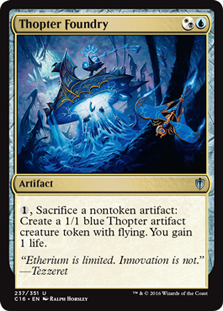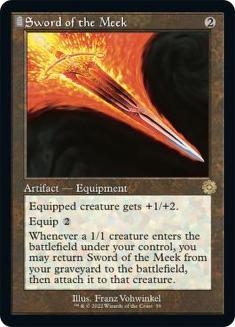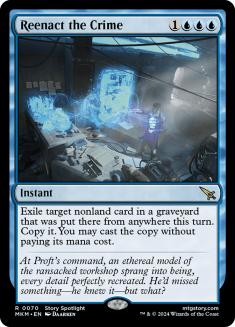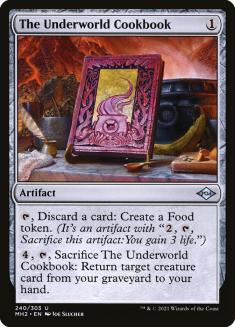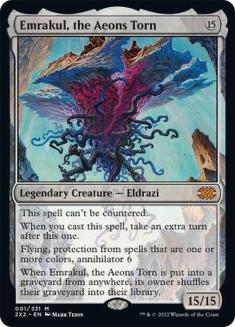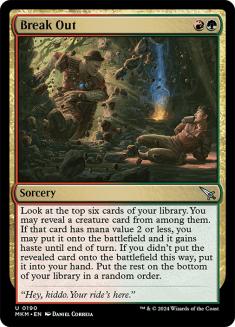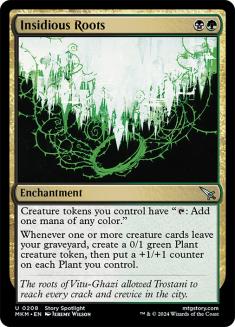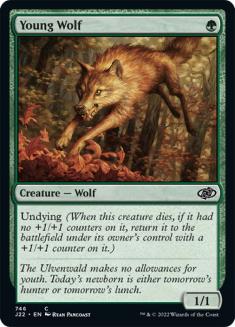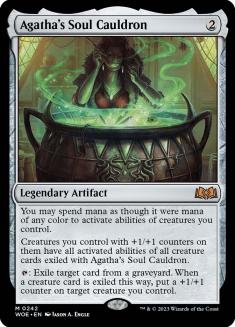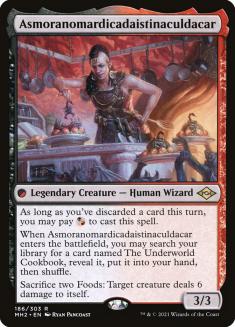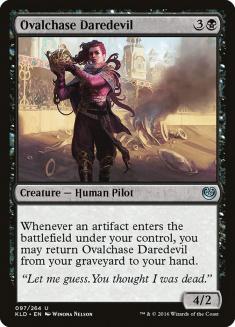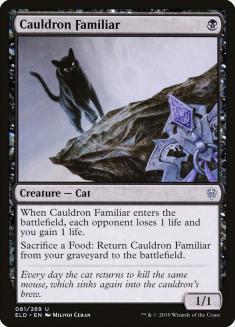There’s a lot to figure out in Murders at Karlov Manor and no obvious heroes or villains. You can safely assume that Lightning Helix or a reskinned Mana Leak will make their mark in Standard, but once you aim higher, all bets are off. With this cycle of Modern Regional Championships in full swing (and this set making its debut next week in Denver and Ottawa) and a lot of exciting build-around cards in this set, anyone who can crack that case will reap the rewards.
Surveil Lands
The mana-fixing cycle in this set takes on a new importance in a fetchland format.
The Theros Temples never went mainstream in Modern. Fair decks had better options like Celestial Colonnade and Raging Ravine, or wanted to start curving out Turn 1. Temples only looked appealing if you were crafting a single turn with a single card and wanted to make that as consistent as possible. No matter the colour pair, playing a Temple was a clear sign that you were up to no good.
Legends tell of a generation of pure combo decks that used to roam Modern alongside extinct predators like Splinter Twin and Summer Bloom. Ad Nauseam would happily spend the first few turns just playing Temples and unlocking some ‘free’ card selection from their lands; the more disjointed Goryo’s Vengeance decks begrudgingly played some Temples to stitch together their various two-card combos.
Few traces of these decks survive today, and for good reason. Pure combo is increasingly hopeless against the free interaction in the Modern Horizons sets, so you have to splice a combo finish into a fair deck that wants to be casting Preordain or Prismatic Ending rather than playing a Temple.
Why Not Both?
You no longer have to choose! The surveil lands add yet another layer of flexibility to fetchlands, letting every Flooded Strand pretend to be Temple of Enlightenment (that can also be an Island when you badly need an untapped land). The rare manabases that still featured a bunch of Temples can convert those into one or two surveil lands and more fetchlands instead.
The shift from scry to surveil is usually an upgrade given the prevalence of graveyard synergies in Modern. Even decks without an explicit graveyard theme can often benefit there (milling a creature for Agatha’s Soul Cauldron in Golgari Yawgmoth, for example). It’s not a strict upgrade, though. Decks that rely on finding specific singletons from their library at the right time or keeping those at bay until the combo turn would prefer to tuck them away with scry rather than losing them outright with surveil. Maybe your Yawgmoth deck doesn’t want to draw that Hapatra, Vizier of Poisons yet but wants the option to Chord of Calling for it once you have a confirmed route to Yawgmoth itself. Scry preserves that, while surveil doesn’t.
Homes for Surveil Lands
Any deck with a lot of fetchlands – most Modern decks – can consider working in the right surveil land, but where is this likely to stick?
Izzet
The Izzet decks might look like obvious candidates – lots of fetchlands plus a prior interest in surveil for delirium and more – but mana curve considerations trump everything else here. Izzet Guildgate is impossibly awkward in a deck designed to be full of one-drops and two-drops – Spirebluff Canal entering tapped in the mid-game is rough enough! You also have so much card selection that a surveil land has less of a unique upside here.
Rakdos Evoke
Rakdos Evoke also aims to play a small game with cheap cards but once it has forced the game in that direction it wants to find the right follow-up. It lacks blue’s card selection and is prone to disjointed draws because of how polarized its cards are, making a surveil land more tempting there.
Slow and Fair
The slower and fairer decks in Modern can afford that tapped land more, but many of them want to stretch their mana for Leyline Binding and have to play multiple tapped lands with some mix of Triomes to enable that. It’s hard to squeeze in a surveil land too if you think that only brings a marginal upside. Azorius Control may get away with both Triomes and a surveil land, but a deck like Four-Color Creativity faces a tougher choice, as its manabase is so fragile and full of other ‘tapped’ lands like Dwarven Mine.
This is a good illustration of the subtle benefit Yorion, Sky Nomad brought to these manabases – you could play more lands like this that you rarely wanted to draw but wanted to fetch alongside more fetchlands, maximizing your access to them while drawing them less often.
Amulet Titan
Temple of Mystery hasn’t appeared in Amulet Titan since the Summer Bloom days. Amulet Titan has too many appealing lands, and that nice problem to have only gets worse with each set, while new payoffs like The One Ring make it easier to have and find more action. Surveil is also worse than scry with no ways to exploit the graveyard and lots of one-of lands that want to stay in the deck for searching up later.
That said, getting to reuse the same surveil land with bouncelands goes a long way, and some mix of fetchlands, Generous Ent, and opposing copies of Boseiju, Who Endures means you can find it reasonably often.
Cascade
The safest bet for surveil lands is the Cascade decks. Temur Rhinos doesn’t get to do much before Turn 3, but it desperately needs to hit its third land and have a relevant spell on that turn, making it easier and more important to fetch a surveil land early. Lórien Revealed gives you another way to find the Simic or Izzet surveil lands, a clean swap for the Ketria Triome in stock lists. Though some Rhinos herders have tried to cut the Triome because drawing it as a tapped land later can be so punishing, the upside of surveil may be enough to bring them back.
Collect Evidence
The most ambitious collect evidence cards, like Analyze the Pollen, have steep costs at first glance, but some familiar tricks make those more accessible.
These are the same tricks that wore out Up the Beanstalk’s welcome in just a few months. There’s no sense of achievement or discovery left to this creative accounting with cards like Street Wraith. It’s just a question of whether you’ve heard this joke before.
Traverse the Ulvenwald is a good case study for how this worked in the past – and why it might not work so well now. With some of the same supporting cast like Street Wraith and other free ‘placeholders’ like Mishra’s Bauble, reaching delirium was trivial – but then what are you meant to find? Creatures unique and powerful enough to be the centerpiece of a deck tend to have other, clashing setup requirements – you don’t see anyone casting Traverse the Ulvenwald for Yawgmoth, Thran Physician or Puresteel Paladin. The Four-Color Omnath versions with a delirium package of Traverse and Unholy Heat are the most recent and promising example, but those did not survive the banning of Yorion, Sky Nomad.
Leyline of the Guildpact
I’m still not fully convinced Leyline of the Guildpact is real and not some bizarre fever dream or something that would get laughed out of a custom card forum. Until someone lets me in on the joke, I’ll take it seriously – and it gives you a lot to think about.
The most obvious use borrows from Pioneer – few cards supercharge devotion in a Mono-Green Devotion shell quite like this, and it lets the Arbor Elf + Utopia Sprawl package usually seen in the Modern versions work its magic with Nykthos, Shrine to Nyx as a ‘Forest’.
That shell hasn’t flourished in Modern in a long time and this Leyline won’t fix its problems. Why not take a bigger swing?
Domain Ramp
Creatures (10)
Planeswalkers (4)
Lands (26)
Spells (20)

If you fully embrace Leyline’s potential, you can build a ramp deck with one of the weirdest manabases of all time. While Nykthos is pumping out green mana, Cabal Coffers rewards a very different kind of devotion, and you are scaling enough Mountains to trigger Valakut, the Molten Pinnacle – all at the same time!
Even if you are devoted to several colours, you want your payoffs to work no matter which one you are focused on right now, so the colourless payoffs from Tron become the natural starting point. Karn, the Great Creator and The One Ring are all too familiar by now, but Golos, Tireless Pilgrim can find the first Nykthos or another Coffers for even more obscene amounts of mana or a Valakut to establish control and finish off the opponent, with Leyline of the Guildpact giving you the full rainbow to spin Golos activations into more threats.
A resource-intensive ramp deck can’t afford to be all-in on drawing a specific card in its opening hand. Serum Powder gives you better odds of finding the all-important Leyline (at the cost of… well, drawing Serum Powder), but there are more conventional options in this space too. Dryad of the Ilysian Grove is a proven winner that’s perfect for a ramp deck that cares about land count and land types, where its Prismatic Omen effect overlaps with Leyline. Green also gives you Modern’s other standout ramp cards like Arboreal Grazer and Explore, once again making it the ideal base colour that then gives you a route to all the others.
Jeskai Thopter Combo
Creatures (8)
Lands (24)
Spells (28)

Crime Novelist looks like just another fiddly artifact payoff for less powerful formats until you realize it’s one more card that goes infinite with Thopter Foundry and Sword of the Meek. All the alternatives in Modern cost more mana, are harder to cast, or ask more from you. Crime Novelist is a cheap-ish chap who can enable those fast combos but also benefits from the Mishra’s Baubles and Spellbombs that your artifact toolbox deck already wants.
Reenact the Crime
You can pull off some amazing heists in Modern thanks to free discard outlets like The Underworld Cookbook and big prizes like Emrakul, the Aeons Torn. Reenact the Crime can add some much-needed redundancy to existing shells like Goryo’s Vengeance or take a different route with Legacy classics like Omniscience and Enter the Infinite.
These decks are part of the variety that gives Modern its charm, but they are easy to contain if they become popular. Grief and Endurance are nightmares for these decks, and it won’t always be this easy to forget about Teferi, Time Raveler.
Break Out
Break Out stirred a lot of excitement among fans of creature combo decks, but I’m less optimistic. You need the main piece or all relevant pieces to fall under its scope to make it worthwhile, but the combos that meet that description all have bigger systemic issues. This card looks great for Devoted Druid, yes – but we say that about a new card every few months, and none of them bring it back to life! Those shells are suppressed by the quality of interaction in the format. It doesn’t matter how good your other enablers are if every round is an uphill battle against Unholy Heat and Solitude.
The creature combo decks that have put up results recently don’t have room or time for this card. Selesnya Heliod passed that torch to Golgari Yawgmoth a while back, but neither deck’s namesake falls in range of Break Out. This card’s breakout performance may have to wait.
Insidious Roots
Golgari Yawgmoth is the big winner from this first set of Regional Championships, and Insidious Roots aims for a starring role there. Loops with the titular Yawgmoth, Thran Physician already involve undying creatures like Young Wolf entering and leaving the graveyard repeatedly, and Insidious Roots can substitute for a second undying creature to sustain this indefinitely. Agatha’s Soul Cauldron is another recent transformative printing that conveniently shuttles cards out of your graveyard on demand.
That’s a good start, but these scenarios assume you already have several of your key cards in place, so why do you need the help? Yawgmoth already has more support than it can use at any one time – former staples like Strangleroot Geist and Eldritch Evolution are stuck on the bench – so the bar for any new player is high, and I don’t expect Insidious Roots to clear it.
The Asmo decks enjoy shuttling Ovalchase Daredevil between zones and using these trinkets to bring back creatures ranging from Cauldron Familiar to Feasting Troll King, but the same problem is even more obvious here. You get enough of a reward from doing this already, and when you don’t have this engine going, you have a mostly dead card that won’t help get things started.
Still, Insidious Roots is exactly the kind of build-around card you want to sprinkle throughout a set like this: exciting and challenging, but unlikely to break a format open with raw power. There is a long list of such cards in Murders at Karlov Manor, and I’ve featured just a few of the prime suspects here. There’s enough to keep Modern fans busy until Modern Horizons 3 grabs our attention and makes us question everything we know.

